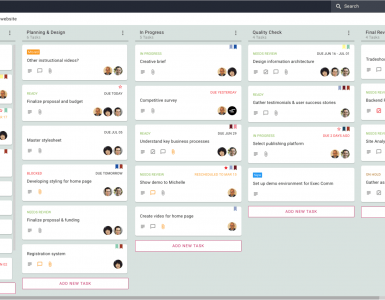If you’re a freelancer, you will undoubtedly want to think about how to raise your rates once in a while.
It’s not just about earning more. It’s also about showing clients that you’re improving your skill set and are ready to take on more complicated projects. That means you’re becoming better at what you do and that clients can trust you with their requirements.
However, you need to observe the proper way to increase fees and charges. While you do deserve that rate increase, your current and potential clients might get scared if you do it the wrong way! For someone in freelancing who depends on client references, that’s not exactly a reassuring thought, is it?
We’ll discuss the right way of raising your rate in this article. But first, let’s answer this question: when is the right time to increase your freelancer fees and charges?
The Right Time To Increase Your Rates
Most freelancers will agree that there is no real benchmark period for increasing your rate. However, we’re certain about one thing: the more skills and experience you have, the better you can justify your rate increase.
To determine if it’s the right time to increase your rates, evaluate what your achievements have been so far. Consider offline seminars and online courses you’ve attended, certifications you’ve gained, the projects you’ve worked on, and their degree of difficulty.
You may also objectively assess your skill level. If you’re a programmer, take online coding tests. If you’re a freelance graphic designer, take online visual designer aptitude exams.
If you’re a writer, take a typing test. And so on. The idea is to see how much your skillset has matured since you first decided to become a freelancer.
How long you’ve been in business should play a role, too. The longer you’ve been in the industry, the more experience you’ll gain. Clients know that experience is the best teacher when it comes to freelancing. If you’ve been doing it for years, you’ve mastered numerous skills, including project management and negotiating with clients.
If your self-assessment shows that you’ve grown as a professional, it’s time to reflect that growth in your fees and charges. Make it a habit to periodically reassess your rates after your first increase, too. Inflation isn’t going anywhere, and as your work-related expenses rise, you need to adjust your rates accordingly.
How To Raise Your Freelancing Fees & Charges
Let’s say you’ve determined it’s the right time to raise your fees. You need to know how to do it without losing your existing clients and scaring away potential ones. Here are some things you should remember so you can add more value to your business without putting off the people who allow you to pay your bills:
1. Limit The Increase
You might be wondering how much you should increase your fees and charges. While a 50% raise would be ideal, you’re bound to lose clients, especially if they haven’t transacted with you for some time or if they feel they’re not getting much out of you.
While your goal is to earn more, your clients also run their businesses, and they have to find space in their budget for you. If you start charging too much, they are likely to find someone else to do your job. Remember that no-one is indispensable.
According to Leaving Work Behind, it’s best to stick to increases between 5% and 10%. If you’re earning $500 for 30 hours of work, a 5% increase means you’ll be getting $525 for the same amount of time. Although $525 doesn’t sound as great as $750, the extra $25 will still help you pay your bills.
It’s easier to justify a 5% to 10% increase to clients. Besides, since you control your time, you can always get more projects if you think a 10% increase isn’t substantial enough on its own. Even with your new rate, you can always find new clients who will be more than happy to hire you.
2. Inform Your Clients Well In Advance
No one likes surprise rate increases. If you send your long-term clients a freelancer invoice with the new fees and charges without informing them in advance, you risk losing them right away. Informing your clients ahead of time is the polite way of doing it.
Notifying them about the rate increase a day before won’t cut it, either. You’ll want your clients to assess your new rates properly so they can accept them once they come, or at least give them time to decide what to do next.
This means you need to inform clients way in advance before you implement the increases. There’s no ideal number for how long “advance notice” should be, but according to Flexjobs, two to three months should be more than enough.
It’s easier if you’re dealing with a new client. Just give your new fees and charges. Don’t forget to include in your contract that you intend to conduct periodic reviews of your rates. When you notify them of an increase in the future, they won’t be surprised at all.
3. Notify Your Clients In Writing
Your advance notice should be written, not verbal. Otherwise, you won’t have much to fall back on if your clients dispute their charges. It’s also a good practice to send the notice as a standalone personalized email, not as a reply or as part of another email.
To give your clients an idea of what to expect, the subject line should be clear and unambiguous. “Rate changes starting February” is a good subject line as it tells the recipient what to expect and when to expect it.
In the body of your email, explain the reasons you are increasing your rates. Focus on the added value you add to your clients’ business, use persuasive arguments and justify the additional costs that you expect to incur for future projects.
For example, the cost of printing documents and images is pretty substantial, and electricity rates are always on the rise. While you can absorb part of the added cost, you are still running a business.
Here’s a sample email you could use as a starting point:
Dear [Name of Client]:
This is to inform you that starting (the date you plan to implement the increase), there will be an increase in my freelance rates from X to Y. This is to help me cover the rising costs of providing quality services to you.
If you have any questions, please don’t hesitate to contact me at (contact number). Thank you so much for your continued patronage. I look forward to continuing working with you.
All the best,
(Your name)
The template above uses simple language and goes straight to the point. Your clients will appreciate it if you don’t beat around the bush. At the same time, they will accept the rate increase if you make them understand how the increase will benefit them, too.
By the way: never apologize for raising your rates. You’re running a business and deserve to get paid what you’re worth.
4. Avoid Implementing Rate Increases With Recently-Acquired Clients
Your long-term clients are not likely to mind a 5% to 10% increase in your rates. Because these clients are already familiar with your capabilities and work ethic, they know your work is worth the rate increase you’re implementing.
This is not the case with your recently-acquired clients or those who have been working with you for six months or less. If you inform them about the planned increase, they are more likely to reject it. They might even think you’re trying to pull a fast one on them, even if you notify them in advance.
With recently-acquired clients, focus on proving your worth first. Deliver on your promises, follow deadlines, and produce great results. Your goal is to make them see your value.
This way, when you do inform them of a change in your fees and charges, they’ll agree without any hesitation because they know you’re worth every penny they will shell out.
5. Be Flexible When Dealing With Long-Term Clients
Let’s say you’ve notified your long-term clients about your new rates. However, one client tells you they’d like to retain you but can only afford the increase if they pay it on a staggered basis for the duration of the project.
Based on your previous projects with the client, you know they’re not one to renege on their promise and are easy to work with too. What do you do?
In those instances, it pays to be a bit flexible about your terms. You wouldn’t want to lose a great client just because they can’t afford your new rates right away. It’s not like they’re not paying you more at all. They’re just not able to do it now because they have their financial constraints to work with.
However, you shouldn’t just say yes to every request from these long-term clients. If another client proposes the same arrangement but has a history of not paying you on time or in full, then agreeing to their proposal may not be such a good idea.
You need to assess each case carefully and decide to put limits on your flexibility.
Wrapping Up
As a freelancer, you have the right to increase your rates. Your fees and charges should reflect your growth in the industry and the quality of the work you do. Without the increase, your business will be stagnant, and there won’t be any room for your professional growth.
However, you need to follow the proper way of raising rates. If you do it the wrong way, you can quickly lose clients. Because your business depends on finding new clients and keeping them, you have to do everything you can to keep them happy with your work and your rates.
In this article, we looked at how you should mindfully increase your freelancing fees and charges. Be strategic about it.
Be flexible, especially with long-standing clients, but firm if needed, too. I’d like to hear from you if you’ve successfully raised your rates. How did you do it, and how did it go? Leave a comment down below!











